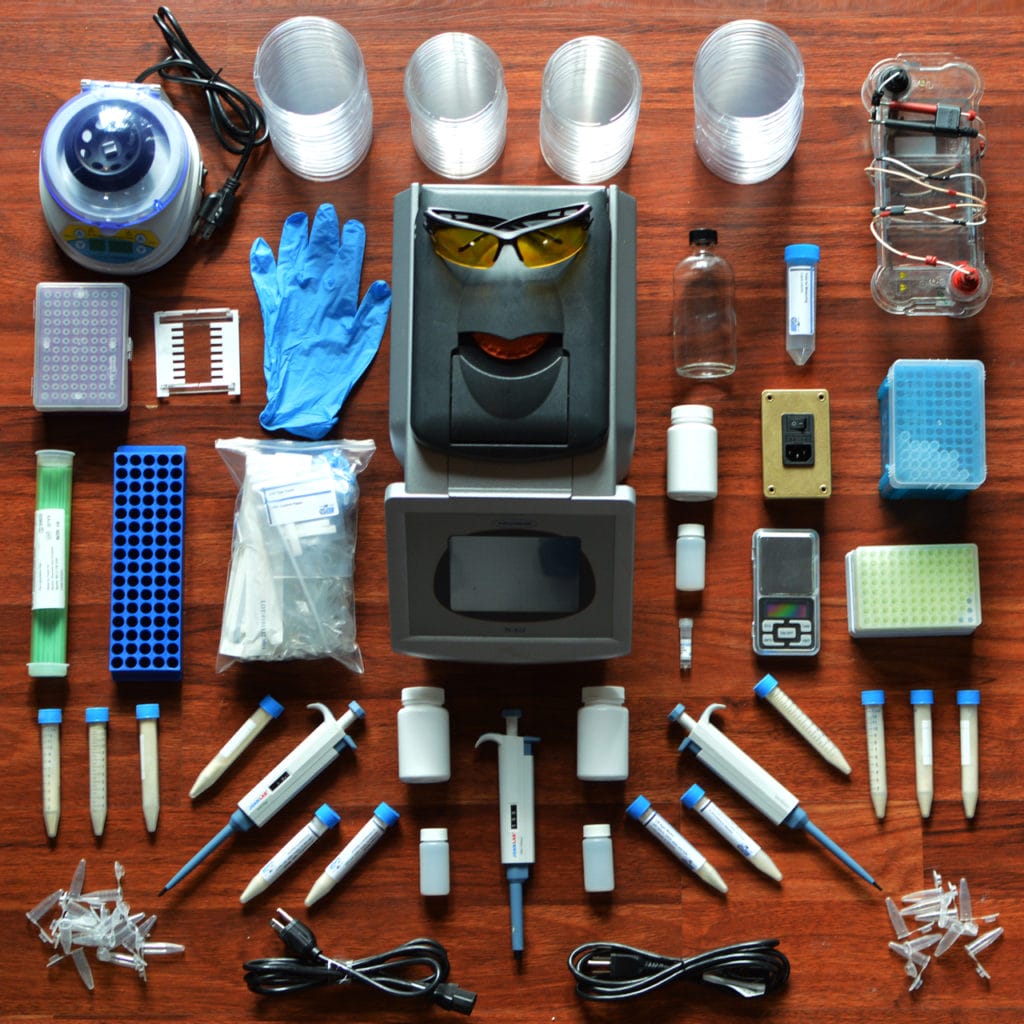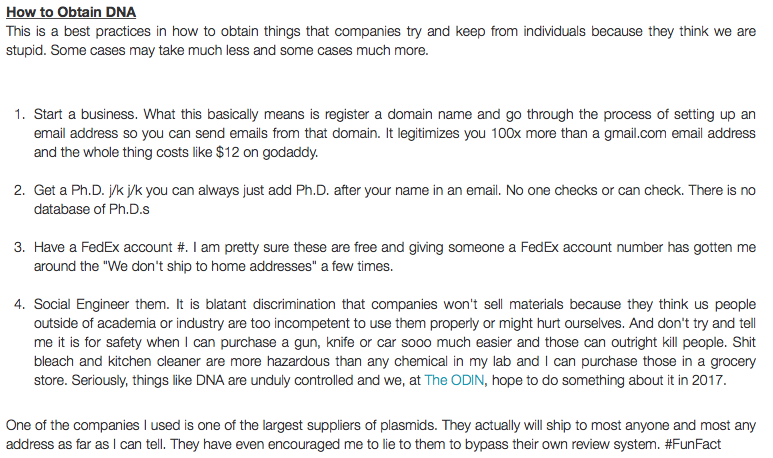In realtà è il presente, nel senso che già vi sono stati esperimenti, ma di cosa parliamo? Che cosa è il bio hacking?
Il bio hacking è l’alterazione del DNA proprio o di un’altra persona, iniettando nel corpo una versione modificata dello stesso. Il pioniere di biohacker è senza dubbio Josiah Zayner, scienziato, biologo che nel 2016 si è impiantato una versione modificata del proprio DDNA per farsi crescere i muscoli. L’impresa, apparentemente banale, apre frontiere molto preoccupanti sulle possibilità di alterazione genetica illegale che potrebbero presto diffondersi nella rete. Zayner, dal canto suo, è sempre stato piuttosto eclettico, ha creato una birra fluorescente usando una proteina apposita, ha creato uno strumento chiamato Chrimochord
stimulates light-, oxygen-, and voltage-sensing proteins and translates their reactions into music.
Appunto, un eclettico eppure la preoccupazione c’è: sia perché la ricerca genetica è un mistero che poco si conosce, sia perché la paura è che sia la DarkNet a diventare il principale mercato per questi esperimenti. Il bio hacking è senza dubbio il futuro per tante cose: nuovi tipi di cure, nuovi tipi di droghe, nuovi tipi di…armi e non è poi così tanto fantascientifica come cosa considerando che lo stesso Zayner ha creato una società per la distribuzione di kit di alterazione genetica. Trovate tutto sul sito ufficiale di Zayner (http://www.the-odin.com) compreso lo store online con il kit completo che vedete anche qui sotto.

Prima accennavo ad un sito, per l’esattezza un blog nel quale Zayner ha descritto le sue esperienze. Bene, questo sito è il seguente (http://www.ifyoudontknownowyaknow.com). Indagando un pochino all’interno della rete dedicata bio-hacking, le opinioni su Zayner si dividono ferocemente. C’è chi lo considera un millantatore senza quasi alcun fondamento di ingegneria genetica e c’è chi ne vede il pioniere di tale branca ma il punto è: fino a che punto è possibile modificare il DNA di una persona e con quali risultati? Ad ogni si ignora la complessità del codice genetico ma i risultati di esperimenti importanti sono noti e pubblicati a chi è interessato (https://www.ncbi.nlm.nih.gov/pmc/articles/PMC4883596/) si cerca, ad esempio, di combattere la distrofia muscolare progressiva. Si cerca di curare le malformazioni muscolari nelle malattie genetiche intervenendo ex-post la nascita.
I toni di Zayner nei confronti della scienza sono tutt’altro che “bonari”. Anzi, spesso ci si imbatte in testi come quello che segue che fanno riflettere:
I received an email over a year ago from Lars. His wife Dyanne, a never smoker, had developed Non-Small Cell Lung Cancer. He was reaching out to me to see if CRISPR would be a viable way to try and treat his wife. He lamented at how the medical system and academic scientists he contacted had given up on her to die.[…]
See the fucked up thing about the world is not the scammers peddling fake cancer treatments, it’s the medical doctors peddling infinite wisdom but refusing to do anything, much less everything that they can to help someone who is dying. What lengths would you be willing to goto to save your loved one or partner and does not every human deserve that same dignity and respect? Maybe you say this is irresponsible as if letting someone die without the right to do whatever they want with their body is totally fine.[…]
As I write this there are people dying of cancer and other diseases. Maybe close to home, maybe far away. But if they don’t inspire you to learn more, work harder and try harder. What the fuck are we doing Science for?
Fonte: http://www.ifyoudontknownowyaknow.com/2017/10/diy-guide-to-creating-peptide.html
La mia personale idea è che per quanto possano essere assurde le convinzioni di un uomo in campo scientifico, senza alcuna controprova empirica bisogna andarci piano nel giudicarlo un folle. Anche quando si leggono frasi come queste sul “brain copying” ossia sulla copia della mente.
This is still not a crazy idea. We can already use microelectrode implants in the brain or even just basic EEG to control a prosthetic. The algorithms and electronics that control these actions become a simplistic yet real part of the brain. But, without the brain that part is nothing. In effect, the goal of consciousness networking is to slowly(or perhaps even quickly) replace brain portions so the consciousness is never separated from the “brain”. If the consciousness is ever separated is it still you or just a copy? I believe it is just a copy.
Fonte: http://www.ifyoudontknownowyaknow.com/2015/06/copying-your-brain-wont-save-you-from.html
Volutamente alla fine vi lascio la descrizione Zayner, così capite di chi stiamo parlando.
Dr. Josiah Zayner is a global leader in the BioHacker movement, constantly pushing the boundaries of Science outside traditional environments. He started BioHacking during his Ph.D. in Molecular Biophysics at the University of Chicago, creating The Chromochord in his apartment, the world’s first musical instrument that uses engineered protein nanotechnology. After his Ph.D., Josiah received a prestigious fellowship to work with NASA’s Synthetic Biology program, engineering bacteria to help terraform Mars. Now he is the Founder and CEO of The ODIN. Josiah has a number of Scientific publications and awards for his work in protein and genetic engineering and is also recipient of Art awards for creating Speculative Science works that have been featured in museums across the world, including NY MoMA PS1. His work has been featured in Time, Scientific American, Popular Science, Businessweek, The Verge and NPR, among many others. He enjoys Whiskey and Red Bull, sometimes together.
Fonte: http://www.the-odin.com/about-us/
Dello staff di Zayner fa parte anche un nome noto…molto noto: George Church
George Church is Professor of Genetics at Harvard Medical School and Director of PersonalGenomes.org, which provides the world’s only open-access information on human Genomic, Environmental & Trait data (GET). His 1984 Harvard PhD included the first methods for direct genome sequencing, molecular multiplexing & barcoding. These led to the first genome sequence (pathogen, Helicobacter pylori) in 1994 . His innovations have contributed to nearly all “next generation” DNA sequencing methods and companies (CGI-BGI, Life, Illumina, Nanopore). This plus his lab’s work on chip-DNA-synthesis, gene editing and stem cell engineering resulted in founding additional application-based companies spanning fields of medical diagnostics ( Knome/PierianDx, Alacris, AbVitro/Juno, Genos, Veritas Genetics ) & synthetic biology / therapeutics (Joule, Gen9, Editas, Egenesis, enEvolv, WarpDrive ). He has also pioneered new privacy, biosafety, ELSI, environmental & biosecurity policies. He is director of an IARPA BRAIN Project and NIH Center for Excellence in Genomic Science. His honors include election to NAS & NAE & Franklin Bower Laureate for Achievement in Science. He has coauthored 425 papers, 95 patent publications & one book (Regenesis).
Fonte: http://www.the-odin.com/about-us/
L’abbattimento dei costi degli accessori per la manipolazione genetica ha permesso a Zayner di aprire un eShop alla portata di qualsiasi tasca (da 10 a 1.800 dollari) permettendo potenzialmente a chiunque di intervenire sul proprio DNA. Si tratta di una rivoluzione, silenziosa, ma in atto da anni che vede progressi e sempre maggior attenzione anche da parte delle istituzioni.
At The ODIN(http://the-odin.com), I have been trying to provide cheap prices and single researcher size quantities to DIY Scientists to allow them to do experiments. After lots of contemplation, I want to move away from my job as a Scientist at NASA because I think big things can happen in DIY just like what came of the computer hackers in the 90s. I want to help that stuff happen by creating more resources and tutorials for people.
Fonte: http://www.ifyoudontknownowyaknow.com/2015/09/wildtype-vs-mutant.html
Parliamo molto spesso di piccole organizzazioni, gruppi che procedono auto-finanziandosi o con l’intervento di appassionati o persone bisognose di cure. Fate ben attenzione a quanto riportato di seguito: è un approccio sicuramente polemico destinato a far parlare in modo critico. Lo scrive Zayner sul suo sito (http://www.ifyoudontknownowyaknow.com/2017/01/genetic-designer-part-ii-dna-got-what-i.html)

Comprenderete perfettamente che il punto 2, per quanto suscettibile a critiche, apre un argomento di riflessione legato alla frase “There is no database of Ph.D.s“, ma questo esula dallo scopo dell’articolo.

